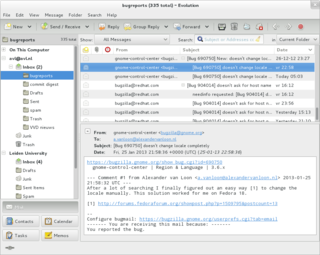Related Research Articles

Electronic mail is a method of transmitting and receiving messages using electronic devices. It was conceived in the late–20th century as the digital version of, or counterpart to, mail. Email is a ubiquitous and very widely used communication medium; in current use, an email address is often treated as a basic and necessary part of many processes in business, commerce, government, education, entertainment, and other spheres of daily life in most countries.
Automatic message exchange (AME): In an adaptive high-frequency (HF) radio network, an automated process allowing the transfer of a message from message injection to addressee reception, without human intervention. Through the use of machine-addressable transport guidance information, i.e., the message header, the message is automatically routed through an on-line direct connection through single or multiple transmission media.
In telecommunication, speed of service is the time for a message to be received. For example:
- The time between release of a message by the originator to receipt of the message by the addressee, as perceived by the end user.
- The time between entry of a message into a communications system and receipt of the message at the terminating communications facility, i.e., the communications facility serving the addressee, as measured by the system.
The Message Passing Interface (MPI) is a standardized and portable message-passing standard designed to function on parallel computing architectures. The MPI standard defines the syntax and semantics of library routines that are useful to a wide range of users writing portable message-passing programs in C, C++, and Fortran. There are several open-source MPI implementations, which fostered the development of a parallel software industry, and encouraged development of portable and scalable large-scale parallel applications.
The Internet Group Management Protocol (IGMP) is a communications protocol used by hosts and adjacent routers on IPv4 networks to establish multicast group memberships. IGMP is an integral part of IP multicast and allows the network to direct multicast transmissions only to hosts that have requested them.
In Modern English, we is a plural, first-person pronoun.
An email address identifies an email box to which messages are delivered. While early messaging systems used a variety of formats for addressing, today, email addresses follow a set of specific rules originally standardized by the Internet Engineering Task Force (IETF) in the 1980s, and updated by RFC 5322 and 6854. The term email address in this article refers to just the addr-spec in Section 3.4 of RFC 5322. The RFC defines address more broadly as either a mailbox or group. A mailbox value can be either a name-addr, which contains a display-name and addr-spec, or the more common addr-spec alone.
A blind carbon copy is a message copy sent to an additional recipient, without the primary recipient being made aware. This concept originally applied to paper correspondence and now also applies to email.

An address is a collection of information, presented in a mostly fixed format, used to give the location of a building, apartment, or other structure or a plot of land, generally using political boundaries and street names as references, along with other identifiers such as house or apartment numbers and organization name. Some addresses also contain special codes, such as a postal code, to make identification easier and aid in the routing of mail.
The Aeronautical Fixed Telecommunications Network (AFTN) is a worldwide system of aeronautical fixed circuits provided, as part of the Aeronautical Fixed Service, for the exchange of messages and/or digital data between aeronautical fixed stations having the same or compatible communications characteristics. AFTN comprises aviation entities including: ANS providers, aviation service providers, airport authorities and government agencies, to name a few. It exchanges vital information for aircraft operations such as distress messages, urgency messages, flight safety messages, meteorological messages, flight regularity messages and aeronautical administrative messages.
The posting rule is an exception to the general rule of contract law in common law countries that acceptance of an offer takes place when communicated. Under the posting rule, that acceptance takes effect when a letter is posted ; the post office will be the universal service provider, such as the UK's Royal Mail, the Australia Post, or the United States Postal Service. In plain English, the "meeting of the minds" necessary to contract formation occurs at the exact moment word of acceptance is sent via post by the person accepting it, rather than when that acceptance is received by the person who offered the contract.
In the broadest sense, a code is a correspondence or rule between patterns. It can be an arrangement of physical matter, including the electromagnetic spectrum, that stores the potential to convey meaning. For instance, the pattern of vibration we call 'sound' when activated within the mind, triggers an image; say the word "cat". Also, seeing the shapes we call 'letters' forming the word makes one think of or visualize a cat. The words upon the screen were conceived in the human mind, and then translated into computer code.
Decoding, in semiotics, is the process of interpreting a message sent by an addresser (sender) to an addressee (receiver). The complementary process – creating a message for transmission to an addressee – is called encoding.
Encoding, in semiotics, is the process of creating a message for transmission by an addresser to an addressee. The complementary process – interpreting a message received from an addresser – is called decoding.
The Korean language has a system of linguistic honorifics that reflects the social status of participants. Speakers use honorifics to indicate their social relationship with the addressee and/or subject of the conversation, concerning their age, social status, gender, degree of intimacy, and situation.

Mix networks are routing protocols that create hard-to-trace communications by using a chain of proxy servers known as mixes which take in messages from multiple senders, shuffle them, and send them back out in random order to the next destination. This breaks the link between the source of the request and the destination, making it harder for eavesdroppers to trace end-to-end communications. Furthermore, mixes only know the node that it immediately received the message from, and the immediate destination to send the shuffled messages to, making the network resistant to malicious mix nodes.

Privacy and Electronic Communications Directive2002/58/EC on Privacy and Electronic Communications, otherwise known as ePrivacy Directive (ePD), is an EU directive on data protection and privacy in the digital age. It presents a continuation of earlier efforts, most directly the Data Protection Directive. It deals with the regulation of a number of important issues such as confidentiality of information, treatment of traffic data, spam and cookies. This Directive has been amended by Directive 2009/136, which introduces several changes, especially in what concerns cookies, that are now subject to prior consent.
In linguistics, an honorific is a grammatical or morphosyntactic form that encodes the relative social status of the participants of the conversation. Distinct from honorific titles, linguistic honorifics convey formality FORM, social distance, politeness POL, humility HBL, deference, or respect through the choice of an alternate form such as an affix, clitic, grammatical case, change in person or number, or an entirely different lexical item. A key feature of an honorific system is that one can convey the same message in both honorific and familiar forms—i.e., it is possible to say something like "The soup is hot" in a way that confers honor or deference on one of the participants of the conversation.

An ARRL radiogram is an instance of formal written message traffic routed by a network of amateur radio operators through traffic nets, called the National Traffic System (NTS).
Broadcast to Allied Merchant Ships (BAMS) was a protocol and system of broadcasts for Allied merchant ship convoys that was used during World War II to provide for the transmission of official messages to merchant ships in any part of the world. The BAMS system is designed for communication by the best employment of radio stations available.
References
- ↑ Martin H. Weik (6 December 2012). Communications Standard Dictionary. Springer Science & Business Media. p. 370. ISBN 978-1-4615-6672-4.
![]() This article incorporates public domain material from Federal Standard 1037C. General Services Administration. Archived from the original on 2022-01-22.
This article incorporates public domain material from Federal Standard 1037C. General Services Administration. Archived from the original on 2022-01-22.